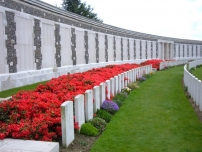| First Name: | Arthur William | Last Name: | COPAS | |
|---|---|---|---|---|
| Date of Death: | 16/08/1917 | Lived/Born In: | Vauxhall | |
| Rank: | Private | Unit: | Royal Berkshire1/4 | |
| Memorial Site: | Tyne Cot Memorial, Belgium | |||
Current Information:Born-Vauxhall
Third Battle of Ypres This was a campaign fought between July and November 1917 and is often referred to as the Battle of Passchendaele, a village to the north-east of Ypres which was finally captured in November. It was an attempt by the British to break out of the Ypres salient and capture the higher ground to the south and the east from which the enemy had been able to dominate the salient. It began well but two important factors weighed against them. First was the weather. The summer of 1917 turned out to be one of the the wettest on record and soon the battlefield was reduced to a morass of mud which made progress very difficult, if not impossible in places. The second was the defensive arrangements of concrete blockhouses and machine gun posts providing inter-locking fire that the Germans had constructed and which were extremely difficult and costly to counter. For 4 months this epic struggle continued by the end of which the salient had been greatly expanded in size but the vital break out had not been achieved. The Battle of Langemarck This took place between 16th-18th August, 1917 and was the second general attack of 3rd Ypres. Although it did not rain during the two days of the battle itself there had been plenty of it in the preceding days and in many places the battlefield was a quagmire. On the left of the attack in the north-west of the Ypres salient there was considerable success, especially for the French Army which attacked on the left of the British, but the attack on the Gheluvelt Plateau, due east of Ypres, met determined German resistance and the early gains were soon reversed. At 4.45am on 16th August, 1917, 145 Brigade of 48th Division attacked in the northern part of the Ypres salient from a position in front of St Julien. The brigade used the 1/5th Gloucestershire, 1/1st Oxford & Bucks Light Infantry and the 1/4th Oxford & Bucks Light Infantry battalions for this operation with the 1/4th Royal Berkshire battalion in support. They attacked in four waves and had as their objectives, first the Green Line, following roughly the Winnipg-Lanngemarck road, second the Red Line, a system of German trenches beyond this road and third the Blue Line running from Clifton House through Tirpitz, Stroppe and Hubner Farms. The attack started well but once they had topped the ridge that ran east of the Steenbeek, a small stream that ran across the line of advance, they met considerable machine-gun and rifle fire from a series of reinforced concrete pillboxes.1/5th Gloucestershire had a hard fight to capture the enemy strong hold in the most northerly house of St Julien and after that progress was slow and limited as it had to contend with heavy crossfire coming from Hillock Farm and Maison du Hibou. Some from the leading waves of 1/1st Oxford & Bucks made it as far as Hillock Farm but not many of them made it back. 1/4th Oxford & Bucks came under machine-gun fire from Mon du Hibou and from the right flank but then, reinforced by second wave, the advance continued until it was stopped by deadly machine-gun and rifle fire from concrete pill boxes at a point 100yards short of a line through Mon du Hibou and Triangle Farm. The barrage was lost, most company officers were casualties so they dug in and consolidated what gains they had made and fought off a number of enemy counter-attacks. A company from 1/4th Royal Berkshire was sent forward to guard the left flank and at 7.30pm a company of 7th Worcestershire, from 144 Brigade in reserve, attacked Mon du Hibou but failed to capture it. There were many casualties among those from 48th Division involved in this operation, one of whom was Arthur Copas of 1/4th Royal Berkshire.
|
||||
| « Back to Search Results | ||||
| If you think any of the information shown here is incorrect, Click Here to submit your amends and comments | ||||




